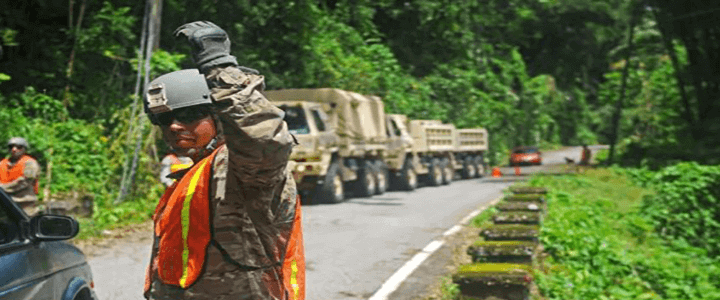Tactics win battles, logistics win wars. And in the battle against time in the Hurricane Maria relief efforts, logistics are the main stumbling block. This week, Daily Intel examines the military assets available to the civilian authorities coordinating the relief efforts.
The president has received a fair amount of criticism from his opponents for the pace and quality of the federal response to the crisis. Some of this was inevitable. The president has a habit of tweeting about things that aren’t the public’s highest priorities, and his most vocal opponents will never give him the benefit of the doubt. But not all the criticism is deserved.
THE JONES ACT DISTRACTION
Last week, the Department of Homeland Security had initially said it would not waive the provisions of the Jones Act, officially called the Merchant Marine Act of 1920. This law requires that cargo moving between two U.S. ports do so on a ship built in the U.S., manned by American merchant marines, and owned by American companies. This means that a Japanese vessel, for instance, could not dock in the Port of Miami, unload its cargo, load supplies for Puerto Rico, and deliver them to San Juan.
Critics of the Jones Act say it needlessly inflates the price of goods in places like Puerto Rico and Hawaii. While the U.S. shipping industry naturally disagrees, that is beside the point here. The question the critics should ask is “is there a shortage of U.S. owned ships to deliver relief supplies to Puerto Rico?”
So far, there is no evidence that there is such a shortage. In fact, the Maritime Labor Alliance, a coalition of six labor unions that represent the shipping industry’s workers, there are 15 vessels currently serving Puerto Rico, which “are now bringing in more supplies than can be distributed ashore.” Therein lies the heart of the problem.
the sheer scale of the challenge
CNN reported Thursday that there are 10,000 shipping containers filled with necessary goods sitting in the Port of San Juan. Jose Ayala, a spokesman for shipping company Crowley, told CNN that the company’s terminal is at capacity, with 3,000 containers waiting to be dispatched.
Ayala said a lack of drivers (who are also victims of the hurricane, remember), a lack of fuel, and the severe damage Maria dealt to the island’s roads and bridges are the main issues. So what can the federal government, especially the military, do?
The military is very good at tackling logistics challenges, but the challenges in getting goods out of San Juan are massive. A 20-foot standard dry shipping container can hold more than 61,000 pounds of cargo. Most of the containers visible in the CNN piece on the Crowley shipyard are newer 53-foot containers, which although longer can carry only up to 56,000 pounds of cargo each. This means that in the Cowley shipyard alone, there is up to 168 million pounds of cargo, including food, clothing, medicine, and construction supplies, waiting to move to where it’s needed.
And the longer it sits in the terminal, the longer other, perhaps more critical, cargo cannot come ashore, regardless of who owns the ship it’s coming on.
Tomorrow: The USS Wasp is on the scene.




